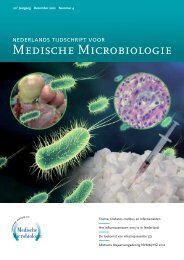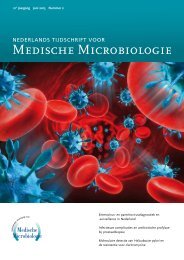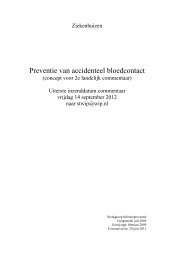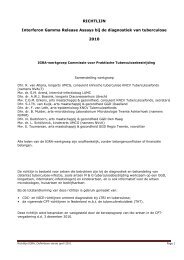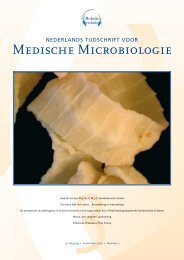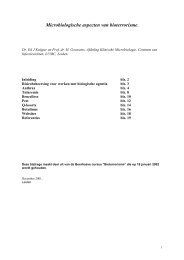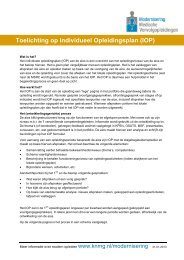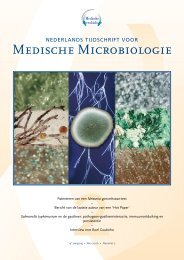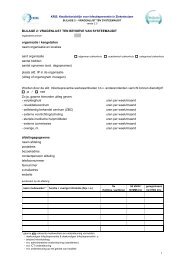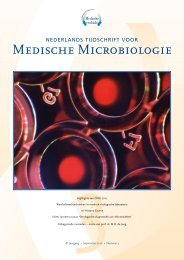Supplement bij veertiende jaargang, april 2006 - NVMM
Supplement bij veertiende jaargang, april 2006 - NVMM
Supplement bij veertiende jaargang, april 2006 - NVMM
Create successful ePaper yourself
Turn your PDF publications into a flip-book with our unique Google optimized e-Paper software.
with the purpose of supplying a surplus of ribosomes in<br />
an environment with fluctuating nutrient concentrations,<br />
enabling cells to start growing quickly when nutrient<br />
concentrations increase. In contrast, our models suggest<br />
that the experimentally observed regulation is optimal with<br />
respect to growth rate.<br />
The second phenomenon we studied was the use of<br />
metabolically efficient and inefficient pathways in microorganisms.<br />
When given the choice of two alternative<br />
metabolic pathways, one with high metabolic efficiency<br />
but using many enzymes, and one with low metabolic<br />
efficiency but using less enzymes, our models predict<br />
that it is optimal to use the metabolically efficient pathway<br />
at low growth rates and the inefficient pathway at high<br />
growth rates. Such behaviour is observed, for example, in<br />
lactic acid bacteria that use mixed acid fermentation at low<br />
growth rates and homolactic fermentation at high growth<br />
rates, or in yeast that start producing alcohol aerobically at<br />
high growth rates.<br />
Our models are characterized by a highly simplified<br />
description of a complete growing system and include some<br />
known physical and biochemical constraints. We show that<br />
such simple models can help in understanding growth-rate<br />
dependent regulation. They may be used as a starting point<br />
for more detailed descriptions in systems biology.<br />
06.22<br />
Unravelling the complexity of flux regulation<br />
S. Rossell<br />
Free University, Amsterdam<br />
An important question is to what extent metabolic fluxes<br />
are regulated by gene-expression or by metabolic regulation.<br />
There are two distinct aspects to this question: (i) the local<br />
regulation of the fluxes through the individual steps in<br />
the pathway, and (ii) the influence of such local regulation<br />
upon the pathway’s flux. We developed regulation analysis<br />
so as to address the former aspect, for all steps in a<br />
pathway. We demonstrate the new method for the issue of<br />
how Saccharomyces cerevisiae regulates the fluxes through<br />
its individual glycolytic and fermentative enzymes when<br />
confronted with nutrient starvation. Regulation was<br />
dissected quantitatively into: (i) changes in maximum<br />
enzyme activity (V max – called hierarchical regulation),<br />
and (ii) changes in the interaction of the enzyme with the<br />
rest of metabolism (called metabolic regulation). Within<br />
a single pathway, the regulation of the fluxes through<br />
individual steps varied from fully hierarchical to exclusively<br />
metabolic. Existing paradigms of flux regulation (such as<br />
single- and multi-site modulation, and exclusively metabolic<br />
regulation) were tested for the first time for a complete<br />
pathway, and falsified for a major pathway in an important<br />
model organism. We propose a subtler mechanism of flux<br />
Ned Tijdschr Med Microbiol <strong>2006</strong>; 4:<strong>Supplement</strong><br />
S39<br />
regulation, with different roles for different enzymes, i.e.<br />
‘leader’, ‘follower’ or ‘conservative’, the latter attempting to<br />
hold back the change in flux. This study makes the subtlety,<br />
so typical for biological systems, tractable experimentally,<br />
and invites reformulation of the questions concerning the<br />
drives and constraints governing metabolic flux regulation.<br />
07.01<br />
In vitro susceptibility of Biofilm growing Staphylococcus<br />
aureus bovine mastitis isolates<br />
M.B. Melchior1 , J. Fink-Gremmels 1 , W. Gaastra2 1<br />
University Utrecht, Veterinary Pharmacology, Utrecht,<br />
2University Utrecht, Bacteriology, Utrecht<br />
Biofilm growing Staphylococcus aureus are related to chronic<br />
infections in human medicine since the 1990s, while in<br />
bovine mastitis S. aureus is well known for its therapy<br />
resistance in chronic infections. Biofilms are a structured<br />
community of bacterial cells enclosed in a self-produced<br />
polymeric matrix and adherent to an inert or living surface.<br />
Several in vitro studies have shown that bacteria growing<br />
in biofim can become 10-1000 times more resistant to the<br />
effects of antimicrobial agents compared to planktonic,<br />
free floating bacteria of the same strain. Current antibiotic<br />
susceptibility testing according to CLSI guidelines show<br />
that, in general, S. aureus mastitis isolates have good susceptibility<br />
for most therapeutic agents, however therapy results,<br />
especially in more chronic cases, are often disappointing.<br />
Objective of this research was to test susceptibility of<br />
several S. aureus mastitis strains growing in Biofilm, for<br />
a panel of 10 antimicrobials in cation adjusted Mueller-<br />
Hinton broth and milk, in order to compare these results<br />
with outcomes of clinical trials.<br />
Results show that several several S. aureus therapeutics<br />
have very poor efficacy against Biofilm growing bacteria,<br />
despite their good efficacy against planktonic bacteria.<br />
07.02<br />
growth condition dependent esp expression and Biofilm<br />
formation of Enterococcus faecium (efm)<br />
W.J.B. van Wamel, M.J.M. Bonten, J. Top, R.J.L. Willems<br />
UMC Utrecht, Medical Microbiology, Utrecht<br />
Background: Hospital outbreaks of vancomycin-resistant<br />
Efm are primarily caused by strains belonging to MLSTbased<br />
clonal complex 17 (CC17), which is characterized by<br />
the presence the Efm variant of enterococcal surface protein<br />
(Esp). Esp of Enterococcus faecalis (homologous up to 90%<br />
with Efm Esp) is involved in initial adherence and biofilm<br />
formation. To explore the role of Esp in the pathogenesis of<br />
Efm, Esp expression was studied under different growth<br />
conditions and the role of cell surface associated Esp in<br />
primary attachment and biofilm formation was assessed.




